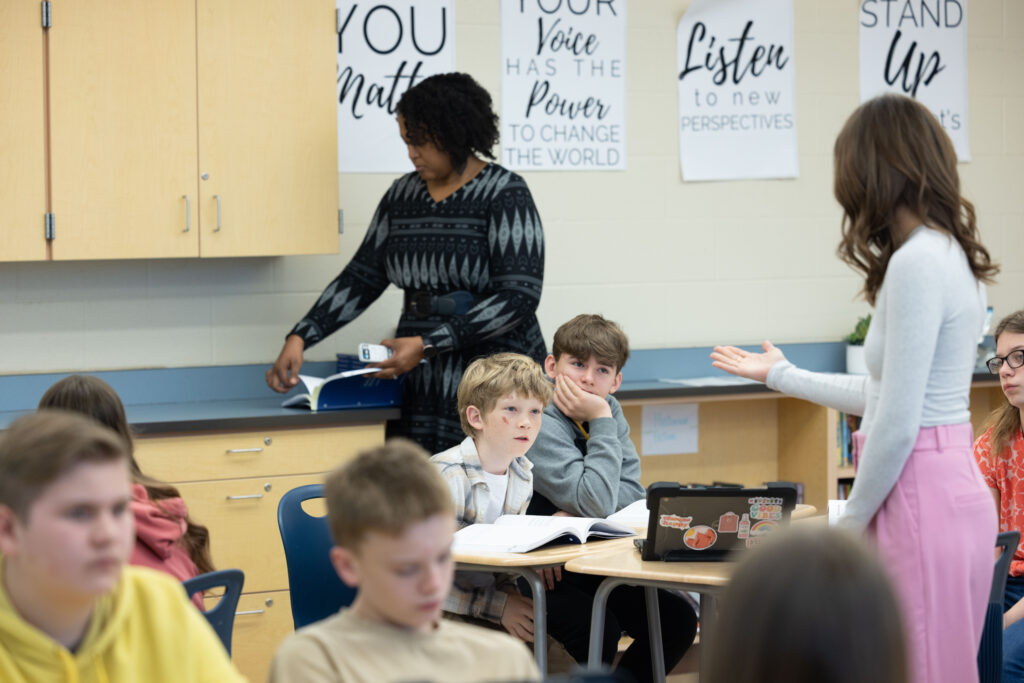May 2023

Where We Started
During the 2021-2022 school year, we entered into the initial phases of co-teaching. At this point in time, Amanda was supporting students with IEPs (Individualized Education Plan) in one of Tom’s 8th-grade Core Connections, Course 3 classes. Our planning time was inconsistent to non-existent. We were still learning how to communicate with and trust each other, and we did not have in-depth conversations about how our seemingly contradictory goals for the students could better align. This caused conflict in our expectations and how we were approaching teaching and supporting students within the classroom. Although dissent is a necessary component of collaborative co-teaching, our disagreements were not followed up by collaborative problem-solving.
To establish the credibility of both teachers in the eyes of students, we worked with our CPM coach to create a circulation pattern where we were almost always on separate sides of the room, circulating in a consistent pattern so that we both were able to interact with all students.
Initially, we were both unaware of the mathematical assets all students could bring into the inclusive classroom environment because we had not built relationships with all students. Amanda could name mathematical assets for her students with IEPs, and Tom could name mathematical assets for the non IEP students, which was a result of our circulation patterns. Amanda’s circulation pattern focused on students with IEPs while Tom’s circulation pattern focused on students without IEPs, and this led to us focusing on separate groups of students. We operated as if it were almost a pullout class within a general education classroom, rather than teaching and operating as one inclusive classroom with two teachers supporting all students. This did not allow us to build relationships with all students within the classroom, only within our groups.
Our Transition to True Co-Teaching
At the beginning of the 2021-22 school year, we began working with our CPM coach, John Hayes, to improve both our individual teaching methods and our collaborative co-teaching methods. Throughout the year, we transitioned to both of us supporting all students. Our planning became slightly more consistent as the year progressed, but we still had a long way to go in our communication and collaboration.
To establish the credibility of both teachers in the eyes of students, we worked with our CPM coach to create a circulation pattern where we were almost always on separate sides of the room, circulating in a consistent pattern so that we both were able to interact with all students. This supported us in working with and supporting all students collaboratively, rather than distributing the labor of supporting students with IEPs to Amanda and students without IEPs to Tom. This helped us build relationships with students with whom we did not typically interact. We think it also might alleviate some status issues that used to arise when we taught students with IEPs as more of a separate class within the general education classroom.
During our collaboration times, we started talking about upcoming lessons and discussed the lesson goals. By the end of the 2021-2022 school year, we had established a circulation pattern, worked through conflict related to goals and supports, collaborated with our CPM coach to identify individual and collective goals, and began establishing relationships with all students. We were a few small steps closer to effectively co-teaching.
A Turning Point
Our CPM coach encouraged us to apply for CPM’s Teacher Research Corps (TRC) as a co-teaching team to further our skills and contribute to research related to the impacts of co-teaching. Our TRC team decided to study the impact of encouraging students to show growth over time by restructuring our teaching and grading practices. We were excited to start this school year with a shared focus that would benefit all students.
Where We Are Now
We entered into the 2022-2023 school year with dedicated planning time, effective communication and collaboration skills, and a shared goal for all students. We established a 40-minute planning time at least once per week. During this time, we preview upcoming lessons, discuss questioning strategies and lesson goals, and determine Study Team and Teaching Strategies (STTS—see the Teacher tab in your eBook) to use throughout lessons. During our collaboration, we discuss STTS which might be useful for the lessons. Amanda has made notable growth in her knowledge of STTS. As a result, she is empowered to suggest strategies that might improve student outcomes, such as learning, status, and engagement. We think of this as “disrupting” Tom’s lesson planning process to ensure universal access.
We also collaborate on creating assessments and rubrics. We put thought into what standards are important to assess and when they are appropriate to assess. Throughout this school year, we have also adjusted our rubrics to have more student friendly language, sentence stems for student self-reflection, and standards written above each concept. Amanda has even taken on some responsibility for grading assessments using the rubrics we create together.
Tom still does the majority of the lesson planning, as he is the content teacher, but this time allows both of us to ensure we are on the same page and to make the lesson structure effective for all students. Throughout the class, we have an established circulation pattern to ensure we are both touching base with all students. We both use STTS to support students’ collaboration and understanding of the content. This year, we have shared goals and improved communication, which is supported by our growing foundation of trust both in each other and in the CPM process itself.
Amanda Kadulski & Tom Dagit
Amanda Kadulski, Green Bay, WI, trc-amandamarx@cpm.org; amarx@sdsd.k12.wi.us
Tom Dagit, Green Bay, WI, trc-tomdagit@cpm.org; tdagit@sdsd.k12.wi.us